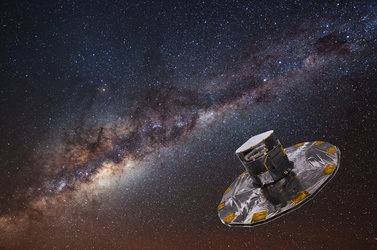The legend of Gaia
For millennia astronomers have looked to the sky and gazed in wonder at the stars and planets. Ancient civilisations already realised that objects in the sky appeared to move in a regular manner, and many communities used the stars to determine when to plant and harvest their crops.
As the oldest branch of astronomy, astrometry is the study of the geometrical relationship between objects in the sky and their apparent and true motions. For many centuries, astronomers have devoted their time to the art of determining the relative position of the stars, a fundamental requirement for cataloguing the night sky.
The true pioneer of the science of astrometry was the ancient Greek astronomer Hipparchus who, in 129 BC, and with only naked eye, observations and simple geometry, catalogued the relative positions of around one thousand stars. He determined their relative brightness and positions with an accuracy of about one degree (the angle equivalent to the apparent height of a person at a distance of 100 m).
Progress in the accuracy of measuring angles only accelerated in the 16th century with astronomer Tycho Brahe’s stellar observations using sextants and quadrants. He managed to fix star positions to an accuracy of about half an arcminute (an arcminute is 1/60 of a degree).
In 1609 the telescope was invented and later in the same century instruments that could be used with telescopes to determine angles in space. Finally, astronomers could determine angles to accuracies greater than the human eye can see.
By the 18th century, accuracies improved to the order of arcseconds, and by the 19th century, fractions of a second of arc.
This finally opened up the ability to measure stellar parallax, the change in the apparent position of a star when viewed from two widely separated positions, for example as viewed from Earth 6 months either side of its orbit around the Sun. Using trigonometry, the parallax angle can be converted to a precise distance. But it is an extremely small quantity – even the nearest star has a parallax of less than 1 arcsecond – making the measurement accessible only to the most sensitive instruments, and only for the nearest stars.
Moreover, these early parallax measurements were limited by viewing through Earth’s atmosphere, which distorted the results and put an upper limit on their accuracy. The only way to really achieve precise measurements would be from space.
In 1989, more than 2000 years after Hipparchus first looked at the heavens, ESA launched a mission named in his honour: theHighPrecisionParallaxCollectingSatellite. ESA’s Hipparcos was the first satellite ever devoted to astrometry, and revolutionised the field of precision astronomy, improving on accuracies achieved on the ground 100 times over, down to just 1 milliarcsecond.
Data were collected between 1989 and 1993, with the resulting Hipparcos Catalogue published in 1997. It contains the positions, distances and movements – 200 times more accurate than any previous measurement – for almost 120 000 stars. A second, larger, catalogue – the Tycho catalogue – contains data of 2.5 million stars to a lesser precision. These catalogues set the precedent on stellar positions and are continuously used in space science research and for spacecraft navigation.
Gaia continues the noble European legacy of star charting. It is destined to catalogue a thousand million stars, measuring each star's position and motion 200 times more accurately than the Hipparcos mission, and producing 10 000 times more data than its predecessor. Equipped with information about each star’s position and velocity, astronomers can trace the past trajectory of stars, ultimately deciphering the history of the Milky Way.
Gaia’s extraordinary precision represents the dream of astronomers throughout history, and brings to light answers to the many questions that have been asked along the way.







